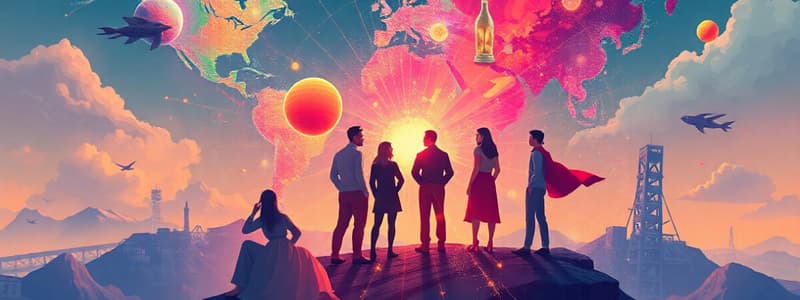Podcast
Questions and Answers
Planned change is always driven by external forces and unforeseen circumstances.
Planned change is always driven by external forces and unforeseen circumstances.
False (B)
Which of the following is NOT a driver of change in organizations?
Which of the following is NOT a driver of change in organizations?
- Globalization
- Technology
- Workforce Diversity
- Personal Interests (correct)
What are the two primary types of organizational change?
What are the two primary types of organizational change?
Planned and Unplanned
Which type of change involves small, gradual improvements within an organization?
Which type of change involves small, gradual improvements within an organization?
_________ refers to companies expanding their operations across international borders.
_________ refers to companies expanding their operations across international borders.
Match the following challenges of globalization with their corresponding descriptions:
Match the following challenges of globalization with their corresponding descriptions:
What are two strategies organizations can implement to effectively manage global communication?
What are two strategies organizations can implement to effectively manage global communication?
Virtual collaboration tools are unhelpful in enhancing global teamwork.
Virtual collaboration tools are unhelpful in enhancing global teamwork.
Which generation is known for being tech-savvy, collaborative, and purpose-driven?
Which generation is known for being tech-savvy, collaborative, and purpose-driven?
The modern workforce is characterized by a decline in mobility and a preference for traditional work arrangements.
The modern workforce is characterized by a decline in mobility and a preference for traditional work arrangements.
What are two examples of cost-cutting measures that organizations may implement during economic challenges?
What are two examples of cost-cutting measures that organizations may implement during economic challenges?
_____ and artificial intelligence are reshaping job roles and demanding new skills from employees.
_____ and artificial intelligence are reshaping job roles and demanding new skills from employees.
Match the change management models with their key steps:
Match the change management models with their key steps:
Which of the following is NOT a benefit of transparent communication during organizational change?
Which of the following is NOT a benefit of transparent communication during organizational change?
Virtual and augmented reality technology can only be used for training and remote collaboration.
Virtual and augmented reality technology can only be used for training and remote collaboration.
What is one ethical consideration that must be addressed when implementing AI and chatbots in internal communication?
What is one ethical consideration that must be addressed when implementing AI and chatbots in internal communication?
Organizations must embrace ______, transparent communication, and adaptability to succeed in a constantly evolving business landscape.
Organizations must embrace ______, transparent communication, and adaptability to succeed in a constantly evolving business landscape.
Which of the following is NOT a key factor driving change in the modern workplace?
Which of the following is NOT a key factor driving change in the modern workplace?
Flashcards
Organizational Change
Organizational Change
Modifications in structure, processes, culture, or technology that influence operations and communication.
Planned Change
Planned Change
Intentional, strategic initiatives led by management like restructuring and technology upgrades.
Unplanned Change
Unplanned Change
Changes driven unexpectedly by external forces such as economic downturns or crises.
Incremental Change
Incremental Change
Signup and view all the flashcards
Radical Change
Radical Change
Signup and view all the flashcards
Globalization
Globalization
Signup and view all the flashcards
Cultural Competency Training
Cultural Competency Training
Signup and view all the flashcards
Localization of Content
Localization of Content
Signup and view all the flashcards
Generational Differences
Generational Differences
Signup and view all the flashcards
Baby Boomers
Baby Boomers
Signup and view all the flashcards
Millennials
Millennials
Signup and view all the flashcards
Remote Work
Remote Work
Signup and view all the flashcards
Change Management Models
Change Management Models
Signup and view all the flashcards
Lewin’s Change Model
Lewin’s Change Model
Signup and view all the flashcards
Transparent Communication
Transparent Communication
Signup and view all the flashcards
AI in Communication
AI in Communication
Signup and view all the flashcards
Cybersecurity Concerns
Cybersecurity Concerns
Signup and view all the flashcards
Ethical Considerations
Ethical Considerations
Signup and view all the flashcards
Study Notes
Changing Organizational Landscapes
- Organizations adapt due to globalization, workforce shifts, economic pressures, and tech advancements.
- Impacts include organizational structure, communication processes, and employee experience.
Understanding Organizational Change
- Organizational change modifies structure, processes, culture, or technology. Affects operations and communication.
- Planned change is intentional, led by management (e.g., restructuring).
- Unplanned change is driven by external forces (e.g., economic downturns).
- Incremental change involves small, continuous improvements.
- Radical change involves large-scale, transformative changes.
Drivers of Organizational Change
- Globalization: Global expansion impacts communication & cultural adaptation.
- Technology: Digital transformation affects employee interaction and tasks.
- Workforce diversity: Demographics influence workplace culture & inclusion efforts.
- Economic pressures: Recessions, inflation, and economic crises drive restructuring.
- Sociopolitical factors: Social movements and regulations affect policy.
Globalization's Impact
- Challenges: Cultural differences, differing time zones, ethical considerations, and intense market competition.
- Strategies: Cultural competency training, content localization, virtual collaboration tools, and diversity initiatives.
Shifting Workforce Demographics
- Generational differences: Baby Boomers, Gen X, Millennials, and Gen Z have distinct communication preferences & values.
- Workforce mobility: Remote & hybrid models, freelancing, and gig economy influence talent competition.
Economic & Technological Pressures
- Economic challenges: Cost-cutting measures, mergers, acquisitions, and changing consumer behavior impact companies.
- Technology's role: Automation AI, big data, and cybersecurity are important factors.
Organizational Responses to Change
- Change management models: Lewin's (unfreeze, change, refreeze) and Kotter's 8-step models are used for transitions.
- Communication strategies: Transparent communication, employee involvement, training, and feedback mechanisms are essential.
Future of Organizational Communication
- Virtual & augmented reality: Enhance training, collaboration, and experiences, useful in onboarding and presentations.
- AI and Chatbots: Automate responses; improve knowledge management and document retrieval via internal communication channels.
- Ethical considerations: Balancing technology efficiency with employee well-being; ensuring diversity, equity, and inclusion are involved in transformations.
Studying That Suits You
Use AI to generate personalized quizzes and flashcards to suit your learning preferences.




